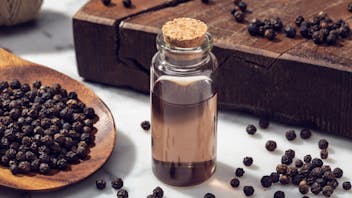Product Overview
We are so very pleased to offer this organic Thyme ct Thymol from Spain, without doubt a special find. The quality of this remarkable Thyme oil is revealed in the exact expression of its predominant chemotype characteristics and properties, and even more so, in the quality of its very fresh, diffusive, powerfully green herbaceous aroma. It is sparkling, crystalline and jewel-like in its ethereal clarity, affirming the presence of the plant’s most precious components – even the most volatile molecules – captured in liquid form.
We love how the producer of our organic Thyme ct Thymol – one of their flagship products – showcases their capacity to masterfully extract, in a few drops of distilled oil, the freshness, wildness and pure authenticity of that rugged countryside. Most species of Thyme are present throughout Spain except for the country’s northern area. In June and July our suppliers are busy ethically wildcrafting in areas of abundance as well as harvesting from their organically cultivated fields.[1] The predominant constituent of this chemotype of Thymus vulgaris is the ‘hot’ monoterpene phenol, thymol, plus smaller quantities of more than a dozen other constituents.[2] This chemotype also contains a moderate amount of carvacrol.
Chemotypes (ct) are the epitome of remarkable adaptability – these genetic and chemical variations occur in plants of identical genus and species when they are grown at different altitudes, in different soils or under different climatic conditions. It has been observed that Thymus vulgaris grown at sea level absorbs more infrared light, producing the ‘hotter’ thymol chemotype, while those plants grown at high altitudes absorb more blue/ultraviolet rays, resulting in the ‘cooler’ linalool chemotype.[3] A chemotype designation determines, to a great degree, both the benefits as well as potential safety considerations of a given essential oil.
In addition to linalool and thymol, Thymus vulgaris also features carvacrol, geraniol, thujanol, cineole and ρ-cymene chemotypes, offering a team of aromatic allies for embracing change. Both the carvacrol and thymol chemotypes of Thyme, which may be used interchangeably[4], are strong skin and mucous membrane irritants (please see Safety Considerations below) and are most safely utilized in diffusers. Essential oils are highly effective at low concentrations. Formulating with higher than recommended percentages is typically unnecessary and potentially harmful. Essential oils rich in phenolic compounds should be used at low dilutions and with appropriate respect. For a Thyme oil to be used in blends for face and body care, please see our gentle linalool chemotype.
1 Industry communication.
2 Ibid.
3 Rhind, Jennifer Peace. Essential Oils – A Handbook for Aromatherapy Practice, 2012, p. 177.
4 Industry Communication.



